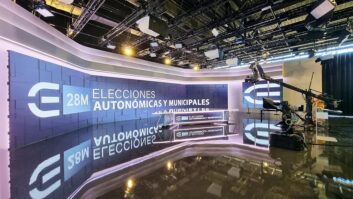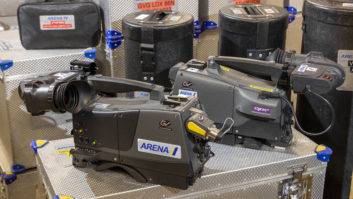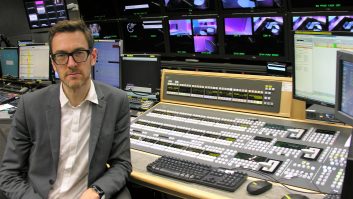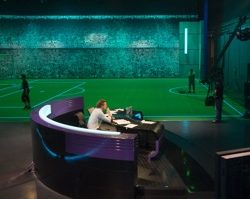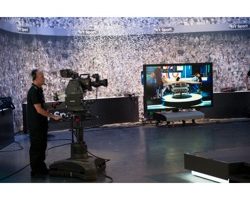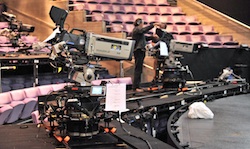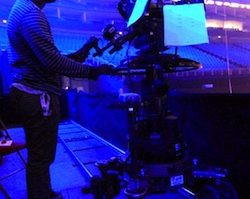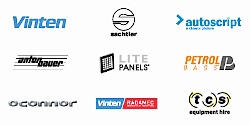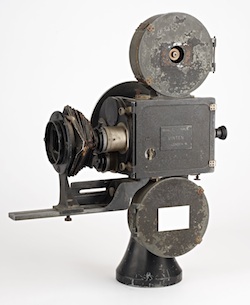
There is a strong tradition of engineering in the UK, not just the big, nation-building things like bridges, tunnels and railways but smaller and more specialised constructions as well. Vinten fits into the second category and over the past 100 years has become firmly established in television, supporting programme making in the most literal sense with its camera pedestals, cranes and moving heads. Kevin Hilton reports.
W Vinten was founded in 1910 by William Charles Vinten, a “very creative engineer” in the words of his son Bill. Over the course of the manufacturer’s first 25 years Vinten Senior produced a huge range of products, usually saying that he would make anything.
The portfolio has changed over the years and while traditional engineering values are still at the heart of what Vinten does, there is more reliance on electronics today. But, as the present managing director, Roger Wilson, says, whatever the means of production and operation Vinten products are used around the world to enable “the art of broadcasting”.
W Vinten was established as a “gear cutting, engraving, small accurate die and press toolmaker” and its first order was taken on 7th January 1910. This was for 25 “Kinemacolor Machines (heavy type)” at £25 each, ordered by cinema pioneer Charles Urban, who had given Vinten the opportunity to run his own workshops.
Vinten was a family business for much of the 20th century. William was supported by his wife Ellen and four of their five children, who decided to join the company. Bill Vinten Junior trained as a mechanical engineer and went on to have an important influence on the later development of the company and its product ranges.
For a while he left the fold and forged a career as a film lighting technician and camera operator. Bill and his elder brother Charles, who became MD and a lead designer on their father’s death, had a “stormy relationship”, which doubtless caused the ‘kerfuffle’ that led to the younger sibling’s departure.
Bill Vinten served with the Royal Navy Film Unit during the War and after demob spent six years at J Arthur Rank’s Gate Studios. Vinten also made a name for himself lighting for television and during the early 1950s worked with High Definition Films Limited, which developed a TV system that transmitted 24fps 35mm footage on a 834 or 625 lines screen.
@subhead:Into television
@copy:By 1952 UK film production was heading into a slump. Vinten went back to the family company and eventually assumed responsibility for its technical direction. Up to that time the firm had been heavily involved with cinema but had diversified into other areas, including reconnaissance equipment during the War and TV.
Vinten saw an opportunity at the BBC, which at the time didn’t have equipment designed specifically for TV. Vinten adapted dollies and pedestals to produce specific TV systems, including the Pathfinder MkII dolly, known as the Marconi, the Hydro-Pneumatic pedestal and the MkIII pan and tilt head.
This took Vinten away from film, although the reconnaissance/military business continued in parallel. Bill Vinten does not claim any great foresight in this, saying he and the company were in the right position with the right experience to meet the demand. “We had the creative engineering talent,” he says, “but I didn’t say ‘We must take the company into TV’, it was the BBC asking for equipment and we responded.”
Vinten’s products have changed over the years but the most significant change came during the 1980s with the introduction of remote controlled robotic camera systems. Vinten was at the forefront of this trend, designing systems for the BBC and ultimately forming a new brand by combining its heads and pedestals with the electronics of Radamec Broadcast Robotics.
Vinten as a company has also grown and changed considerably. The workshops moved from Wardour Street to Cricklewood in northwest London and then, in 1964, to Bury St Edmunds in Suffolk, where the company still has its headquarters. Vinten remembers that the new factory housed 20 to 30 operators working at lathes and other machinery. Now, he says, there are only five to six automatic machines that produce the entire product range. “It’s a different world from 50 years ago,” he observes.
One step ahead
The company floated on the Stock Exchange in the early 1970s and in 1988 was split into two separate entities; Vinten Broadcast to concentrate on the TV market and W Vinten Limited (now Thales Optronics) for the military products. Between 1989 and 1995 the Vinten Group bought several companies in the broadcast support market, including Manfrotto, Bexel, Gitzo and Sachtler. At the end of this period the group was renamed Vitec plc, which in some respects also signified a total break with the past following Bill Vinten’s retirement in 1992, aged 72.
Roger Wilson, who became MD of Vinten two and a half years ago, is keen to respect the heritage of the company but feels that “moving on to the next generation” is also important. “We want the products to develop,” he says, “and there is the whole area of virtual reality and integrating with graphics environments that needs to be addressed. The way TV is made is developing as well and we have to respond to that, which is why we have new versions of pan and tilt heads, for example, that have encoders built in.”
Vinten’s’ products have continued to develop, from those built by William Senior and Charles to the near-iconic Kestrel, Dunlin, Merlin and Fulmar pedestals and heads produced under Bill Junior. (He explains that the trend for ornithological naming came partly from his interest in bird watching but also because the names stood out, rather than being merely “the MkII” or a serial number.)
The Osprey survives in the Vinten catalogue today but it is surround by more pragmatic or marketingese appellations: the Pro5 Plus system, the Quattro L pedestal and the Vector 950 active pan and tilt head. Wilson says the intention is to stay one step ahead of the competition and meet market demands. Despite the recession Vinten recently invested £2 million in new milling machines at the Bury St Edmunds factory to secure its position in the market.
There is often concern that smaller, specialised companies of whatever nationality can be swallowed up by big conglomerates, which usually move production to somewhere else to reduce costs. Vinten has a manufacturing facility in Costa Rica, which is used for higher volume production, although Wilson stresses it matches the factory in the UK. On the issue of ownership Wilson comments that the ‘Vi’ in Vitec comes from Vinten, with each member of the group being autonomous.
There are plans to launch new products to mark Vinten’s 100 years but these were being kept under wraps in the run-up to NAB. Bill Vinten has been retired for 25 of those years and none of his children chose to go into the business. Vinten says he has regular conversations with Lino Manfrotto, his Italian counterpart, and the two sometimes reminisce and tut about the TV business in general.
But his pride in what his father created and what he continued is clear and from his home near the factory Bill Vinten drops in occasionally to keep a grandfatherly eye on what is going on. Some family ties are hard to break.
